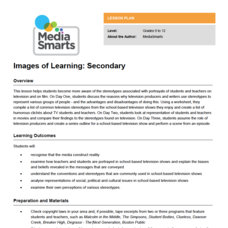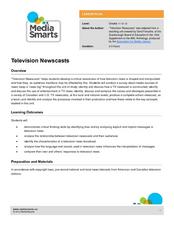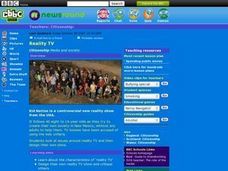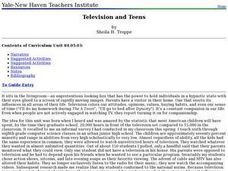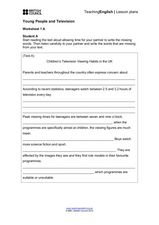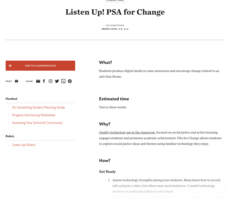Media Smarts
Taking Charge of TV Violence
Encourage your class to become aware of the violence that is present in children's television programs and how this violence can influence children. Do this by holding the planned class discussion in this lesson plan and providing...
Media Smarts
Images of Learning: Secondary
Make your scholars more aware of stereotypical portrayals in film and television. Discuss the definition of "stereotypes" and how they are used to present a story. High schoolers look at specific television shows and complete a chart...
Curated OER
Understanding: Television
High schoolers discuss their experiences with television. They break into small groups and go through the steps of producing a television show themselves. Their presentations are made to the entire class.
Curated OER
Television Newscasts
When we watch news broadcasts on television, we receive a much more visual perspective than when we read the newspaper. How do sets, clothing, and music contribute to our understanding of the story? Compare American and Canadian news...
Curated OER
Violence On TV
Students examine violence on TV. In this data collection instructional activity, students explore TV violence. Students watch TV shows and fill out a checklist about the amount of violence. Students organize and analyze the...
Curated OER
What Make Good Reality Television?
Students brainstorm what they believe makes a good reality TV show. Students compile a set of attributes that they feel distinguishes the best of the reality TV shows from the others. Using the attributes that the class agrees determine...
Curated OER
Class in the Media: Writing a Television Show
Students look at popular media presentations to determine what type of messages they convey about class and class-linked behavior. They listen to contemporary music to explore how the songs touch upon social class issues. They read...
Curated OER
Tee-Hee T.V.
Students examine the concept of satire by reading lyrics to a song and reading "Soap and the Campus: A Web-Site Spoof Succeeds." They create treatments for parodies based on current television shows.
Curated OER
Television and Teens
Students discuss the relationship teenagers have with the television. In groups, they watch different excerpts from various television shows and note every instance of violence including children. They also discuss the instances of...
Curated OER
Rewrite, Revise, Recycle
Students examine different pieces of literature that have a similiar theme. They read an article about reusing ideas for television shows. They work together to create their own program proposals. They also create backstories for one of...
Curated OER
Create a Youth Consumer Magazine
To underscore the importance of being informed consumers, kids check out youth consumer magazines and websites and then create their own. Although no detailed plans are included in the resource, it is packed with ideas and suggestions.
PBS
Reading Adventure Pack: Cooking
A Reading Adventure Pack focuses on cooking. Scholars participate in three hands-on activities after reading the fiction book Easy as Pie by Cari Best and the nonfiction book How Did That Get in My Lunchbox? by Chris Butterworth....
ReadWriteThink
Critical Media Literacy: Commercial Advertising
Commercial advertising—we can't get away from it, but do we realize just how often we are being advertised to? With this lesson, scholars analyze mass media to identify how its techniques influence our daily lives. Learners browse...
Curated OER
"Television"
In this reading comprehension instructional activity, learners read a text about the beginnings of television. Students answer 10 multiple choice questions.
Curated OER
Show Me the Story
Young scholars examine the elements of a story, read a review of Chris Rock's new sitcom, "Everybody Hates Chris" and create original sitcom episodes based on their own lives.
Curated OER
Television: Comedy Vs. Drama
Students investigate the world of Television by contrasting specific programs. In this visual storytelling lesson, students compare and contrast the differences between comedy and drama by making a Venn Diagram. Students...
Curated OER
Writing a TV Advertisement
Students create their own advertisement for their favorite TV show. In this illustrating lesson, students write a paragraph about their favorite TV show then create and advertisement for it. Students then share with the class.
Curated OER
Irregularly Scheduled Programming
Learners examine their favorite holidays and how they are celebrated. After reading an article, they discuss the length of television programming for the Super Bowl. In groups, they create their own television programming relating to...
Curated OER
Create a Country
Young scholars work in small groups to list features and elements found on a variety of grade- appropriate maps. They develop a class list of map features and elements to draw from as they create a map of an imaginary country.
Curated OER
Create a Weather Newscast
Fourth graders explore and study basic weather terms, strengthen research skill on the web and create a weather newscast. They choose a weather site on the web, copy weather maps and create a videotape based on a written script to...
Curated OER
The Lion, the Witch and The Wardrobe: Literature and Theater
Students read and discuss the literary elements of "The Lion, the Witch and the Wardrobe" by C.S. Lewis. They explore the elements of dramatic performance and create a TV news program based on life in Narnia. They videotape their...
Teaching Tolerance
Listen Up! PSA for Change
Challenge scholars to speak up about a topic by creating a public service announcement or social media blitz about an issue they feel passionate about. Have them research their issues, then decide the best way to take their messages to...
Curated OER
Watch and Learn
Students explore a particular problem with the development of new television shows and create original reality-based educational programming.
Curated OER
Pop on the Block
Students consider what makes a movie, television show, musical talent, or artist a cult classic and create descriptive lists of items from these phenomena that may be sold at auction.

